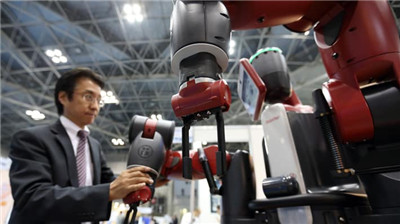The killing of a technician by an industrial robot at a Volkswagen plant in Germany sparked a social media storm this week and raised fears about human safety in the coming era of robotics.
本周,大众汽车(Volkswagen)德国工厂一台工业机器人导致一名技师丧生的事件,在社交媒体上掀起了一场风暴。这件事还让不少人担心,在即将到来的机器人时代中,人类自身的安全会受到威胁。
But experts on artificial intelligence and automation said the incident near Kassel should be understood as an extremely rare industrial accident, rather than a warning about future threats. The accident, in which the robot crushed the man against a metal plate, occurred during installation and involved a fast-moving first-generation robot designed to operate inside a cage, well away from human workers.
但人工智能和自动化专家表示,卡塞尔市(Kassel)附近发生的这起事件,应被理解为一起极为罕见的工业事故,而不是关于人类未来会面临哪些威胁的一次警告。这起事故是在技师装配机器人的过程中发生的,机器人把技师挤到了一块金属板上。涉事的是一台快速移动的第一代机器人,从设计上说,这种机器人是在笼子里工作的,远离人类员工。

“With present technology we cannot ‘blame’ the robot,” said Blay Whitby, artificial intelligence expert at the University of Sussex. “Robots are not yet at a level where their decision-making allows us to treat them as blameworthy.
萨塞克斯大学(University of Sussex)人工智能专家布莱•惠特比(Blay Whitby)表示:“就现有的技术而言,我们不能‘将责任记在’机器人头上。机器人还没到发展到那种程度,我们不应认为它们能为其所做的决策承担责任。”
“This unfortunate accident is technically and morally comparable to a machine operator being crushed because he didn’t use the safety guard,” he added. “In this case it’s more complex and therefore more forgivable because ‘the safety guard’ [at Volkswagen] was provided by computer software and he was in the process of setting it up.”
他补充说:“从技术和道德角度说,这起不幸的事故相当于一名机械操作员因未采取安全防护而被挤死了。具体到这个例子,情况要更复杂一些,因此也更值得原谅,因为(大众的)‘安全防护’是由电脑软件提供的,而他当时正在配置这一软件。”
The next robotic generation — known variously as “workplace assistant robots”, “collaborative robots” or just “cobots” — are designed to operate uncaged alongside people. They incorporate sensors and other safety features to limit the force they can exert and prevent them running amok.
下一代机器人被称为“工作场所助理机器人”、“协作机器人”或简称“Cobot”(collaborative robot的缩写——译者注)。从设计上说,这种机器人是不在笼子里而是在人们身边工作的。这种机器人拥有传感器及其他安防措施,能够限制它们的力气并防止它们横冲直撞。
“Unfortunately people have exaggerated expectations and exaggerated fears about robots,” said Professor Alan Winfield of the Bristol Robotic Laboratory in southwest England. “They have been oversensitised by sci-fi movies and stories in the media.”
英格兰西南部布里斯托机器人实验室(Bristol Robotic Laboratory)的艾伦•温菲尔德(Alan Winfield)教授表示:“很遗憾,人们对机器人的期望和恐惧都过了头。他们被科幻电影和媒体报道弄得过于敏感。”
Professor Sandor Veres, head of Sheffield University’s Autonomous Systems and Robotics Research Group, pointed out that there have been very few fatal accidents with caged industrial robots since the manufacturers began installing them in the 1970s.
谢菲尔德大学(Sheffield University)自主系统和机器人研究小组(Autonomous Systems and Robotics Research Group)主管尚多尔•韦赖什(Sandor Veres)教授指出,自上世纪70年代制造商开始装配在笼中工作的机器人以来,这种致人死亡的事故极其罕见。
Since the first recorded robot killing, in a US Ford factory in 1979, such incidents have occurred at a rate of less than one a year — making up a minuscule fraction of all deaths in industrial accidents.
第一起记录在案的机器人致人死亡事件,发生在1979年的福特(Ford)美国工厂。自那以来,这类事件每年发生不到一起,在所有致人死亡的工业事故中只占极小的比例。
Indeed robotic automation has probably cut the overall death rate in factories, because more people would have been killed through a range of other industrial accidents doing the work replaced by robots.
事实上,机器人自动化很可能降低了工厂中的整体死亡率,原因是假如由人力来做机器人所做的工作,本会有更多的人在一系列工业事故中丧生。













